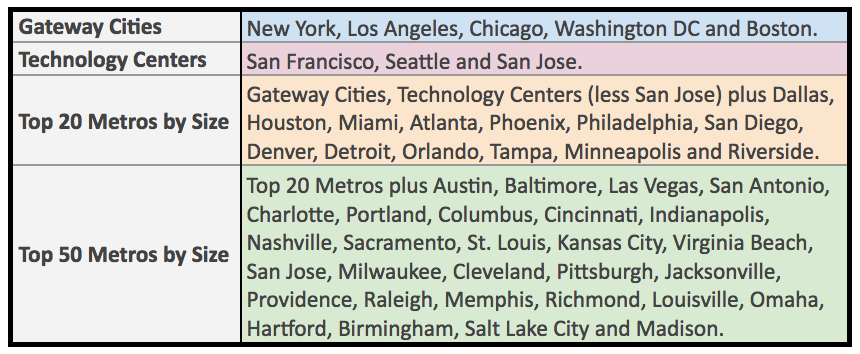What Factors Impact Where Seniors Rent?

Our research illustrates that senior rental location preferences are strongly segmented along both age subgroups and by housing costs. Metro market size also plays a large role.
Senior Growth by Metro Market Segments
In choosing where to rent, senior renters take many factors into consideration. This includes property size, proximity to services at the neighborhood level, amenities within properties and overall housing costs.
As shown below, small asset senior households (age of household head 60+) grew at an annual rate of 4.4% within the Gateway Markets over 2014-15. Small metro areas (the other Top 50 MSAs; see a list of these markets at the bottom of the post) grew at a faster pace of 7.7% during the same time frame.
In complete contrast, senior households living in large properties are growing faster in the regional and large secondary metro markets (Other Top 20 Metros), while the pace is slowing in both the Gateway markets and the smaller metros.
Deeper Dive into Senior Age Groups
A closer look into the age cohorts comprising the senior segment in small properties indicates which senior sub-groups are driving growth by location.
As shown above, Gateway Cities are hugely popular with the younger Baby Boomer households (household heads 60-69 years) growing at a brisk annual rate of 8.6%. The oldest seniors, on the other hand, are avoiding these markets, as their numbers have declined at a 4.4% annual rate.
The regional and large secondary markets (Other Top 20 Metros) are attracting some demand from the older senior cohorts, while the smaller metros (Other Top 50 Metros) are growing at a brisk pace across the board.
In interpreting these trends, it appears that cost considerations are forcing the oldest seniors out of the most expensive metro market segments, while the smaller — and often more affordable — metro areas are benefiting from this relocation.
For property operators, keeping tabs on the demand trends and the locational distribution of an aging population will be critical in timing property improvements to be relevant in a growing market.
For more information on demographic trends in the senior housing and healthcare market, be sure to check out our recent webinar hosted by Seniors Housing News.
The program starts off with an in-depth conversation on demographic demand drivers led by distinguished professor and economist Sam Chandan. After reviewing how this demand is impacting property fundaments within independent living, assisted living and memory care facilities, Arbor finance experts explain how a unique combination of Bridge and FHA loans can benefit senior housing operators.


